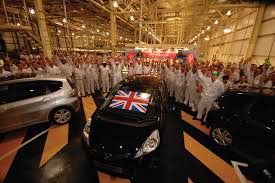1980: Honda enters into a venture with State-owned British Leyland (BL) to build cars in the UK, starting a year later with the Triumph Acclaim, body panels for which are made at BL’s plant in Stratton, Swindon.
1985: After negotiations staged in great secrecy, Honda acquires the disued 370-acre former Vickers airfield at South Marston and sets up a new subsidiary Honda of the UK Manufacturing, giving a clear intention that it intends to start car production. At the time, Swindon was reeling from the final winding down of its historic railworks, which had been the town’s largest employer for around 150 years. 
1986: Honda starts pre-delivery inspection of imported vehicles bound for UK showrooms at South Marston. Talks with local councils take place about manufacturing on the site.
1989: Engine manufacturing starts at South Marston.
1992: After much speculation – and following similar decisions by Japanese rivals Nissan and Toyota – Honda finally announces it is to start car production at South Marston. The first model to roll off the production line is the Honda Accord. A second engine production line is installed on the site as production is ramped up, including for Rover-badged cars.
1994: Production of a new version of Honda’s top-selling Civic small car starts at South Marston, making it a two-model plant.
2000: Swindon-built cars are to be exported to Japan for the first time, Honda announces. Production also starts of the CR-V sports utility vehicle.
2001: A second car assembly plant is opened on the same site, creating 200 more jobs.
2002: Accord production ends.
2006: 700 more jobs created as Honda announces annual production at South Marston will increase by 32% to 250,000.
2008: A further £80m to be invested in new production facilities at South Marston to make plastic car parts and metal engine castings, which previously had occurred off-site.
2009: A fall in sales due to the recession forces Honda to lay off all directly-employed Swindon workers for four months. Contract workers were retained for maintenance work but on lower pay. Production of Honda’s super-mini Jazz starts, pictured.
2012: £267m investment to support introduction of new Civic and CR-V models, and a new 1.6-litre diesel engine line. The workforce is increased to 3,500.
2013: 800 jobs axed as result of weak demand across Europe.
2014: Jazz production ends.
2015: A £200m upgrade and 500 new jobs announced to make the plant the global manufacturing centre for the 10th-generation Civic.
2016: 650 more workers recruited to produce the Civic, taking total workforce above 4,000. Production of CR-V ends. Honda calls on UK government to make a “fast decision” over Brexit and secure a free trade agreement with the rest of the EU.
January 2019 : Honda announces it is to halt production in Swindon for six days in April to stockpile components and help it overcome border disruption after the UK leaves the EU.
February 2019: Closure of plant in 2021 confirmed with the loss of all 3,500 jobs.














